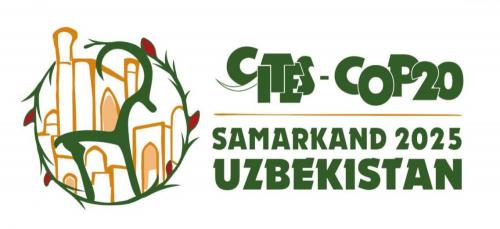
CITES at 50 in Samarkand: Bridging Nature and People
https://cites.org/eng/news/pr/cites-at-50-in-samarkand-bridging-nature-a...
Geneva / Samarkand, 20 August 2025 – With less than 100 days remaining until the opening of the 20th meeting of the Conference of the Parties to the Convention on International Trade in Endangered Species of Wild Fauna and Flora (CITES CoP20) or World Wildlife Conference, the countdown has officially begun.
Today, the host country Uzbekistan unveils the official slogan for the landmark event: "CITES at 50 in Samarkand: Bridging Nature and People."
The slogan reflects both a historic milestone—marking the 50th anniversary of the Convention—and the unique role that Samarkand will play as a meeting point of civilizations, cultures, and conservation efforts. Set to take place from 24 November to 5 December 2025, CITES CoP20 is expected to bring together thousands of scientific, legal, enforcement and trade experts representing governments, intergovernmental organizations, non-governmental organizations, private sector entities, youth networks and more from across the globe.
The announcement was made in Tashkent by His Excellency Mr. Aziz Abdukhakimov, Minister of Ecology, Environmental Protection and Climate Change of the Republic of Uzbekistan, who emphasized the deeper meaning behind the chosen phrase. “This is more than a slogan. It encapsulates our vision for the future—where conservation is not seen as separate from people, but as a shared path forward,” said Mr. Abdukhakimov. “Samarkand, with its centuries-old tradition of connecting East and West, will serve as a fitting venue to celebrate CITES' 50-year journey and shape its course for the years to come.”
The unveiling comes on the heels of Uzbekistan’s recent launch of the CoP20 logo, which drew global praise for blending natural symbols like the Argali and Rhodiola semenovii with Samarkand’s iconic and historical architecture. Together, the logo and the new slogan place a clear focus on the link between biodiversity and sustainable use—a core principle of the CITES framework.

Ms. Ivonne Higuero, CITES Secretary-General, welcomed the announcement: “As we mark half a century of international collaboration through CITES, this slogan captures the spirit of CITES and the role it plays in bringing 184 countries and the European Union to promote co-existence between people and wildlife interlinking science and policy and conserving these species of animals and plants for future generations. It reminds us that effective conservation of wild fauna and flora must be grounded in dialogue, shared purpose, and practical action. We thank Uzbekistan for offering not only a location for our next CoP, but a powerful message to guide it.”
As the 20th World Wildlife Conference, CITES CoP20 is especially significant: beyond commemorating the 50th anniversary of the Convention, it arrives at a time of intensifying pressures on wildlife due to habitat loss, overexploitation, wildlife crime, all exacerbated by the triple planetary crisis of climate change, pollution and biodiversity loss. Decisions taken in Samarkand will influence global wildlife policy for years to come, including potential amendments to species listings and strengthening implementation measures.
Uzbekistan’s hosting of CoP20 also represents a growing recognition of Central Asia’s vital role in global biodiversity conservation. Samarkand, one of the oldest continuously inhabited cities in the world, offers a backdrop of stunning historical significance and unique wildlife such as the Caspian monitor, the Eurasian scops owl and the Turkestan lynx. As the world looks toward November, preparations are accelerating. Proposals for amendments to the CITES Appendices have been submitted, the CoP20 agenda is taking shape, and Samarkand is preparing to open its gates to a global community united by a common cause.
For CITES, for Uzbekistan, and for the planet, the road to CoP20 is well underway—with less than 100 days left to a historic gathering that promises to not only bridge nature and people, but also strengthen the Convention’s achievement of its Strategic Vision—for a world where all international wildlife trade is legal and sustainable.
____________________
Editor’s Notes:
For media enquiries, please contact cites-media@un.org
For general enquiries, please contact info@cites.org
About CITES
The Convention on International Trade in Endangered Species of Wild Fauna and Flora (CITES) was signed on 3 March 1973 and entered into force on 1 July 1975. With 185 Parties (184 countries + the European Union), it remains one of the world's most powerful tools for wildlife conservation through the regulation of international trade in over 40,900 species of wild animals and plants. CITES-listed species are used by people around the world in their daily lives for food, health care, furniture, housing, tourist souvenirs, cosmetics or fashion. CITES seeks to ensure that international trade in such species is sustainable, legal and traceable and contributes to both the livelihoods of the communities that live closest to them and to national economies for a healthy planet and the prosperity of the people in support of UN Sustainable Development Goals.
Follow CITES on social media:
Find out more: https://cites.org/eng









